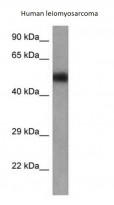ARG59248
anti-GSDMD antibody
anti-GSDMD antibody for Western blot and Human
Pyroptosis Study antibody
Overview
| Product Description | Rabbit Polyclonal antibody recognizes GSDMD |
|---|---|
| Tested Reactivity | Hu |
| Tested Application | WB |
| Host | Rabbit |
| Clonality | Polyclonal |
| Isotype | IgG |
| Target Name | GSDMD |
| Antigen Species | Human |
| Immunogen | Synthetic peptide around the middle region of Human GSDMD. (within the following region: VTIPSGSTLAFRVAQLVIDSDLDVLLFPDKKQRTFQPPATGHKRSTSEGA) |
| Conjugation | Un-conjugated |
| Alternate Names | FKSG10; DF5L; Gasdermin domain-containing protein 1; Gasdermin-D; DFNA5L; GSDMDC1 |
Application Instructions
| Application Suggestion |
|
||||
|---|---|---|---|---|---|
| Application Note | * The dilutions indicate recommended starting dilutions and the optimal dilutions or concentrations should be determined by the scientist. | ||||
| Observed Size | ~ 53 kDa |
Properties
| Form | Liquid |
|---|---|
| Purification | Affinity purified. |
| Buffer | PBS, 0.09% (w/v) Sodium azide and 2% Sucrose. |
| Preservative | 0.09% (w/v) Sodium azide |
| Stabilizer | 2% Sucrose |
| Concentration | Batch dependent: 0.5 - 1 mg/ml |
| Storage Instruction | For continuous use, store undiluted antibody at 2-8°C for up to a week. For long-term storage, aliquot and store at -20°C or below. Storage in frost free freezers is not recommended. Avoid repeated freeze/thaw cycles. Suggest spin the vial prior to opening. The antibody solution should be gently mixed before use. |
| Note | For laboratory research only, not for drug, diagnostic or other use. |
Bioinformation
| Database Links | |
|---|---|
| Gene Symbol | GSDMD |
| Gene Full Name | gasdermin D |
| Background | GSDMD (Gasdermin D) is a member of the gasdermin family. Members of this family appear to play a role in regulation of epithelial proliferation. Gasdermin D has been suggested to act as a tumor suppressor. Alternatively spliced transcript variants have been described. [provided by RefSeq, Oct 2009] |
| Function | GSDMD, N-terminal: Promotes pyroptosis in response to microbial infection and danger signals. Produced by the cleavage of gasdermin-D by inflammatory caspases CASP1 or CASP4 in response to canonical, as well as non-canonical (such as cytosolic LPS) inflammasome activators (PubMed:26375003, PubMed:26375259, PubMed:27418190). After cleavage, moves to the plasma membrane where it strongly binds to inner leaflet lipids, including monophosphorylated phosphatidylinositols, such as phosphatidylinositol 4-phosphate, bisphosphorylated phosphatidylinositols, such as phosphatidylinositol (4,5)-bisphosphate, as well as phosphatidylinositol (3,4,5)-bisphosphate, and more weakly to phosphatidic acid and phosphatidylserine (PubMed:27281216). Homooligomerizes within the membrane and forms pores of 10 - 15 nanometers (nm) of inner diameter, possibly allowing the release of mature IL1B and triggering pyroptosis (PubMed:27418190, PubMed:27281216). Exhibits bactericidal activity. Gasdermin-D, N-terminal released from pyroptotic cells into the extracellular milieu rapidly binds to and kills both Gram-negative and Gram-positive bacteria, without harming neighboring mammalian cells, as it does not disrupt the plasma membrane from the outside due to lipid-binding specificity (PubMed:27281216). Under cell culture conditions, also active against intracellular bacteria, such as Listeria monocytogenes. Strongly binds to bacterial and mitochondrial lipids, including cardiolipin. Does not bind to unphosphorylated phosphatidylinositol, phosphatidylethanolamine nor phosphatidylcholine (PubMed:27281216). [UniProt] |
| Cellular Localization | Gasdermin-D: Cytoplasm, cytosol. Inflammasome. Note=In response to a canonical inflammasome stimulus, such as nigericin, recruited to NLRP3 inflammasone with similar kinetics to that of uncleaved CASP1 precursor. Gasdermin-D, N-terminal: Cell membrane. Secreted. Note=Released in the extracellular milieu following pyroptosis. [UniProt] |
| Highlight | Related products: GSDMD antibodies; GSDMD Duos / Panels; Anti-Rabbit IgG secondary antibodies; Related news: Exploring Antiviral Immune Response RIP1 activation and pathogenesis of NASH |
| Research Area | Pyroptosis Study antibody |
| Calculated MW | 53 kDa |
| PTM | Cleavage at Asp-275 by CASP1 (mature and uncleaved precursor forms) or CASP4 relieves autoinhibition and is sufficient to initiate pyroptosis. [UniProt] |
Images (1) Click the Picture to Zoom In






